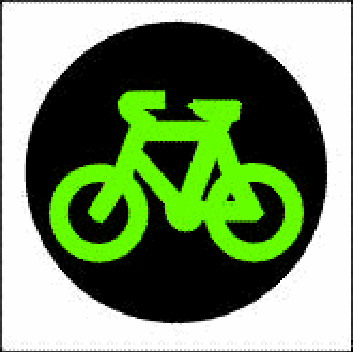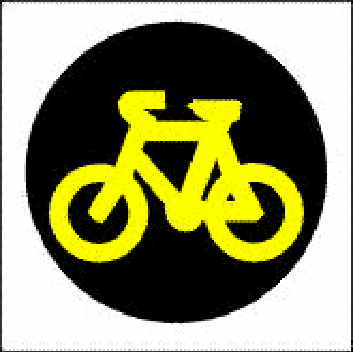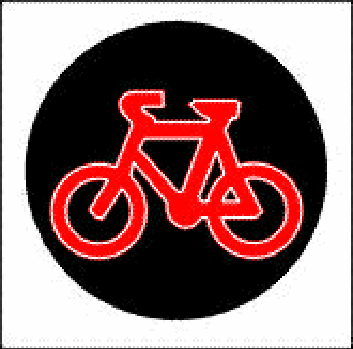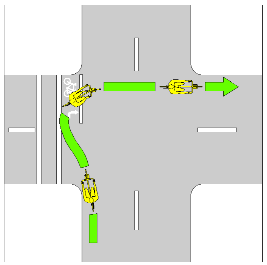Road rules for riding
While there are some road rules which apply only when riding, general road rules must also be followed.
When riding your bicycle on a bicycle accepted path, you must keep to the left of oncoming riders38 and give way to pedestrians when on a shared path or footpath.39
Under NSW law, it is an offence to ride a bicycle:
- negligently; or
- furiously; or
- recklessly.
You can be fined on-the-spot $457 for each behaviour you are displaying.40
What distances do I need to observe when riding my bike
It is an offence to ride too close to the rear of a travelling motor vehicle. You must keep a distance of 2 metres from the rear of the moving vehicle when riding continuously for more than 200 metres.41
Transport for NSW recommends that you keep at least one metre away from parked cars to avoid the risk of colliding with a car door being opened.
Can I ride my bike if I’m being towed by a car or other vehicle?
It is an offence, when riding, to hold onto a vehicle while it is moving.19 A person also cannot ride on a bike that is being towed by another vehicle, except under certain circumstances (see below).
Fines of $344 apply.
If a bicycle trailer is being towed by a bicycle, the trailer being towed cannot have a rider on it unless:
- the rider doing the towing is at least 16 years old, and
- the rider in the bicycle trailer is under 10 years old, and
- the bicycle trailer can safely carry that person, and
- the rider in the bicycle trailer is wearing an approved bicycle helmet, fastened securely to their head.
Fines of $114 apply if these conditions are breached.
Do drivers need to observe distances when passing a bicycle rider?
Drivers who pass to the right of bicycle riders on the road when travelling in the same direction must follow the ‘minimum passing distance’ laws.
Drivers must maintain a certain distance between their motor vehicle and a bicycle rider when passing or overtaking them. These are:
- 1 metre on roads where the speed limit is 60km/hour or less; or
- 1.5 metres on roads where the speed limit is more than 60km/hour.43
The distance is measured between the widest part of the motor vehicle (such as its side mirror) and the widest part of the bike or its rider (such as its handlebars or its rider’s shoulders).
If the minimum passing distance - of either 1 metre or 1.5 metres - cannot be met, the driver is permitted to cross over into the opposite lane or over the dividing line on the roadway to safely pass the rider.44
The driver at all times must have a clear view of approaching traffic.
If a driver cannot pass a rider at these distances, they must slow down and wait until it is safe to pass the rider.
As of 1 July 2019, a driver can be fined $344, and lose 2 demerit points from their driver's license if they fail to observe these minimum passing distances.
Some exceptions to the NSW Road Rules have been put in place to assist drivers in meeting the minimum passing distance.44
Can you take up a road lane?
You are allowed to take up a road lane when riding on the road. However, if there is a bicycle lane (with a 🚲 LANE sign) in the same direction that you are travelling, you must use that lane.46
If it is impractical to ride in the bicycle lane (for example, because of an obstacle or construction works), then you are permitted to ride on the road.
Do you have to obey lane markings on the road?
When riding your bicycle, you must follow lane markings on the road. It is illegal to cross unbroken centre lines. However, you are allowed to ride to the left of a continuous white edge line and over painted islands.47
Do you have to obey traffic lights and traffic signs?
Under NSW law, a bicycle is considered to be a “vehicle”, which means that you must obey the same traffic signs, lights and signals as other drivers.
Heavy fines apply for running road traffic lights and for failing to give way.48 You can be fined $457 for failing to stop at a traffic light or children’s or pedestrian crossings.
Bicycle crossing lights
You can only ride across a pedestrian crossing which has bicycle crossing lights installed. If these lights are not present, you must dismount and walk across the crossing, wheeling your bike beside you. 49
If bicycle crossing lights are present, you must comply with those bicycle crossing lights.



If bicycle crossing lights are red, unless you have already started crossing the intersection in question, you must not proceed to cross until the bicycle crossing lights change to green, or until there are no red or yellow bicycle crossing lights showing.50
If bicycle crossing lights change from green to yellow or from green to red, you must not stay on the road any longer than is necessary to cross safely. For example, they may have to stop on a dividing strip or traffic island until the bicycle crossing lights change to green, or until it is safe to proceed across the road.51
At bicycle crossings you can proceed once the bicycle crossing light is green, even if the main traffic lights are red or yellow.
You may be fined $114 if you are caught disobeying bicycle crossing lights.
Do cyclists have to indicate before turning?
Yes, but only regarding right turns. You do not need to give left or stop signals.
You must signal before turning right or merging into a lane to the right, by extending your right arm horizontally and at a right angle to your bike.52
Remember, when turning, that all turning vehicles must give way to pedestrians who are crossing the road they are turning into.53
Can you go through a red light?
No. You must stop at the stop line unless the traffic (or bike) light is green or flashing yellow.54
Do speed limits apply to you?
Yes. The same speed limits apply to bicycles as apply to other traffic, as bicycles are classified as “vehicles” under the Road Rules.55
Do cyclists have to use bicycle storage areas?
Yes. A ‘bicycle storage area’ is an area at an intersection where you can wait, which cannot be used by other road users. You must use this area when it is marked on the road at an intersection.
When entering a bicycle storage area, you must not enter the storage area from anywhere other than from the bicycle lane.56
Hook turns
Special road rules apply for doing hook turns.57
You may do hook turns at intersections unless signage present indicates it is prohibited. You do not need to signal when making hook turns.

Multi-lane roundabouts
If you are riding in the far left lane of a roundabout with two or more marked lanes you must give way to any vehicle leaving the roundabout at each exit.58
You can make a right turn at a multi-lane roundabout in one of two ways:59
- Use the outer left lane, giving way at each exit to all traffic leaving the roundabout.
- Use the inner right lane and complete the turn in the same way a car would do.
It is also good practice to signal to other drivers what your intended direction is.
Alcohol and drugs
It is an offence to cycle under the influence of drugs. It is an offence to cycle with more than the prescribed concentration of alcohol in your blood (0.05). There are heavy fines and possible imprisonment for these offences.60
Riding in groups
When riding with others on a multi-lane road, only two people are allowed to ride side by side unless you are overtaking.61
If you are riding two abreast, each rider must not be more than 1.5 metres apart. 62
Footnotes
- Road Rules 2014 (NSW) Regulation 251
- Road Rules 2014 (NSW) Regulation 250(2)(b)
- Road Rules 2014 (NSW) Regulation 245-1
- Road Rules 2014 (NSW) Regulation 255
- Road Rules 2014 (NSW) Regulation 254
- Road Rules 2014 (NSW) Regulation 144-1
- Road Rules 2014 (NSW) Regulation 144-2
- Road Rules 2014 (NSW) Regulation 144-2
- Road Rules 2014 (NSW) Regulation 247
- Road Rules 2014 (NSW) Regulation 150(2)
- Road Rules 2014 (NSW) Regulations 56-65
- Road Rules 2014 (NSW) Regulation 248
- Road Rules 2014 (NSW) Regulation 260
Road Rules 2014 (NSW) Regulation 261 - Road Rules 2014 (NSW) Regulation 262
- Road Rules 2014 (NSW) Regulation 49
Road Rules 2014 (NSW) Regulation 50 - Road Rules 2014 (NSW) Regulations 72
- Road Rules 2014 (NSW) Regulation 56
- Road Rules 2014 (NSW) Regulation 20
- Road Rules 2014 (NSW) Regulation 247A
- Road Rules 2014 (NSW) Regulation 35
- Road Rules 2014 (NSW) Regulation 119
- Road Rules 2014 (NSW) Regulation 111
- Road Rules 2014 (NSW) Regulation 298-1
- Road Rules 2014 (NSW) Regulation 151(1)-(3)
- Road Rules 2014 (NSW) Regulation 151(4)

